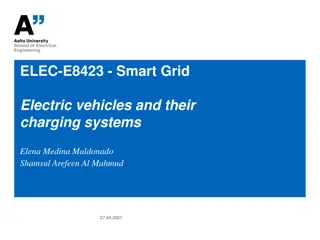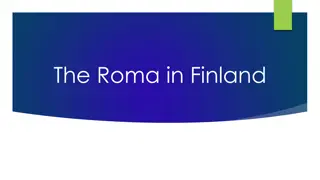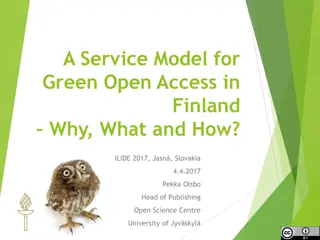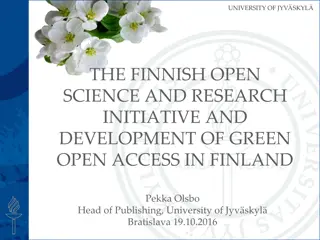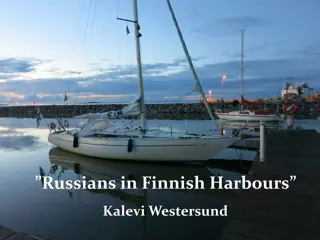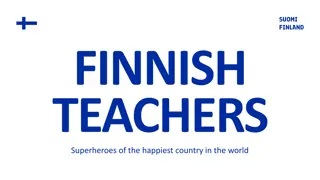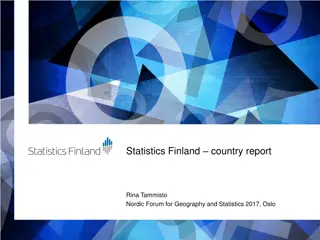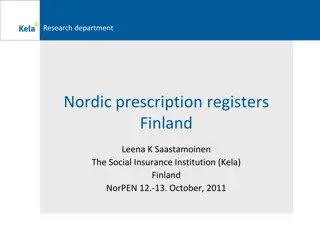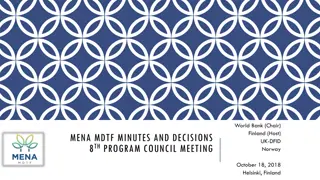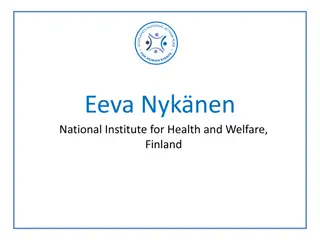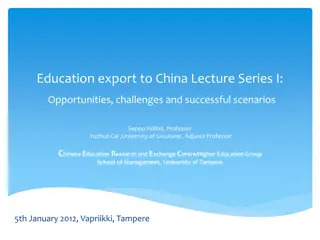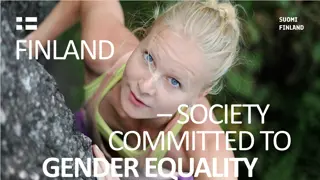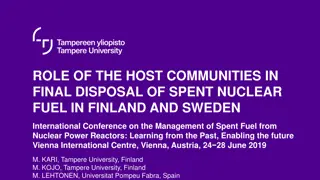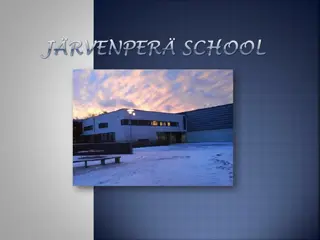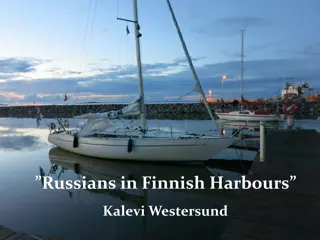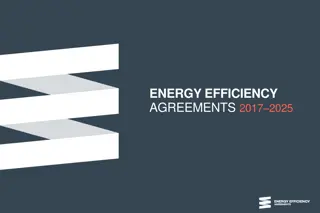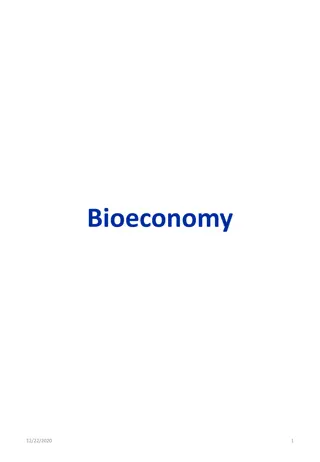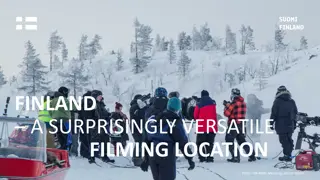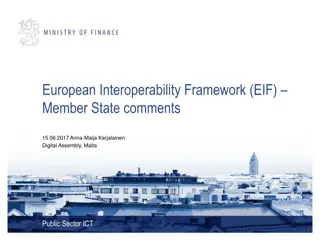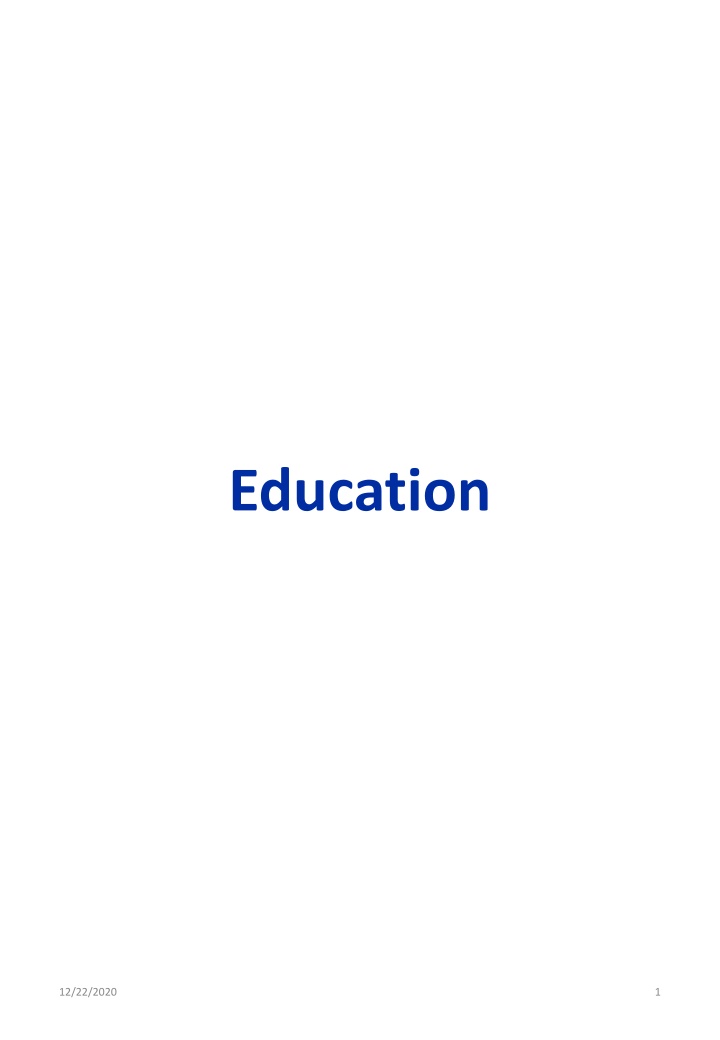
Innovating Education: Finland's Successful Model
Finland's education system is a global benchmark for excellence and efficiency. By focusing on pupil-centered approaches, skilled teachers, and early childhood development, Finland ensures high-quality education with minimal investment. This adaptable system emphasizes lifelong learning and prepares students for the evolving job market. With flexible teaching methods and strong international collaboration, Finland sets a standard for educational innovation worldwide.
Download Presentation

Please find below an Image/Link to download the presentation.
The content on the website is provided AS IS for your information and personal use only. It may not be sold, licensed, or shared on other websites without obtaining consent from the author. If you encounter any issues during the download, it is possible that the publisher has removed the file from their server.
You are allowed to download the files provided on this website for personal or commercial use, subject to the condition that they are used lawfully. All files are the property of their respective owners.
The content on the website is provided AS IS for your information and personal use only. It may not be sold, licensed, or shared on other websites without obtaining consent from the author.
E N D
Presentation Transcript
Education 12/22/2020 1
PART I: GENERAL INFORMATION 12/22/2020 2
Key points and main messages A OECD study in 2018 estimated that many jobs in developed countries could be lost during digital transformation. Our education systems need to innovate and adapt just like the rest of the world is evolving. The modern education system needs to focus on the human, provide her with the skills needed in the new knowledge-based economy and allow for lifelong learning. Finland has one of the highest-quality education system in the world, as shown by consistently high rankings in third-party international studies. Finland has achieved this success despite only spending slightly more per student than the average in OECD countries. The development of the whole education system takes time. Finland created the modern compulsory education system in 1921. Education from pre-primary to higher education is free of charge. High-quality free lunches have been provided to students since 1948. The goal is for everyone to have an equal opportunity to receive high quality education regardless of the family s social or economic background. Differences in the learning results of different schools are small. Early childhood education in Finland is about play and social interaction. A strong early beginning in learning promotes the development of cognitive, social, language and numeracy skills, as well as a motivation and joy to continue learning. Teachers enjoy wide autonomy and have flexibility to organize their own teaching. Both class teachers and subject teachers are required to have a Master s Degree. Finland believes that international cooperation in education is essential. Finnish companies and institutions are eagerly looking for international partners so we can help each other improve. How to portray Finland? Position Finland as having an advanced pupil-focused education system. Highlightthe fact that Finland s education system achieves top results for a modest amount of investment. Profile Finland as the perfect partner and co-learner to develop educational solutions in your own country. 12/22/2020 3
Elevator pitch: The best parts of Finlands education system can be adapted A OECD study in 2018 estimated that many jobs in developed countries could be lost during digital transformation. There exists an urgent need to educate and train people to meet the requirements of future jobs. Finland has one of the highest-quality education system in the world, as shown by consistently high rankings in third-party international studies. For example, Finland is ranked #1 by the Economist in their Educating for the future index, while the OECD says Finland is #2 in the world for the highest performing graduates. Finland has achieved this success despite only spending slightly more per student than the average in OECD countries. Teachers are valued in Finnish society. They are highly educated and trusted to do what is best for every student. Personalized help is common: the Smithsonian notes that nearly 30% of children receive some kind of special help during their first nine years of school. Schools are given a great deal of autonomy. They are not micromanaged nor tightly controlled from a centralized authority. In fact, there is a high level of trust and division of responsibilities between the national and local authorities. Finnish education pays attention to the entire school environment. For example, high- quality free lunches have been provided to students since 1948. Early childhood education in Finland is about play and social interaction. This promotes the joy of earning. A strong early beginning in learning promotes the development of cognitive, social, language and numeracy skills, as well as a motivation and joy to continue learning. Finnish vocational education is a dynamic part of continuous learning. It is developed in close cooperation with industries and emphasizes broad competences, flexible study paths and work-based learning. Many people around the world are fascinated about the Finnish education system and want to learn more. Finnish schools and education methods have become a popular topic in news stories. Finnish education institutions and companies are eager to work with all international partners in education, share what they know and collaborate for new innovations in learning. 12/22/2020 4
Background 1/3 The world is changing rapidly. Advances in technology are making whole industries obsolete, but are also offering new opportunities. Education is the key to evolve and adapt. Education can give us the tools to improve our standard of living while mitigating climate change and the biodiversity crisis. Countries can learn from each other. The best practices in one nation can be adapted to another. People, new technologies, structures, philosophies and processes can also cross borders. Finland has enormous strengths in education which can also be shared with other countries. The development of the whole education system takes time. Finland s love affair with education began exactly 100 years ago, in 1921, with the creation of the modern compulsory education system and the philosophy of education for all. The curriculum and organization of the education system have been updated and reformed several times since. A significant reform began in 1972 with the adoption of the comprehensive school system, meaning that basically everyone has the same opportunities for good quality education in a school nearest to you. The Finnish education system today consists of early childhood education and care, pre-primary, basic, upper secondary (general as well as vocational) and higher education. Education is free from pre-primary onward (early childhood education is subsidized) and school meals are free until the end of secondary education. Meals are subsidized in higher education. Additionally, lifelong learning is emphasized and adult education is available at all levels. Informal education is also encouraged, particularly through library access. The first library in Finland was opened in 1794 and in the 1800s libraries appeared in practically every village. Today every municipality is required by law to provide library services while major research libraries are open to everyone. The information provided by libraries is considered part of society s intellectual capital, which is why basic services are free. 12/22/2020 5
Background 2/3 In the late 1970s the length and rigor of teacher training was increased to meet the needs of learners. In 1979 teachers were required to earn master s degrees. At the end of the 20th Century Finland s economy switched from being focused on natural resources to information and knowledge. New partnerships developed between tertiary education and industry, while primary and secondary education also evolved to promote creativity, problem-solving, teamwork and hard sciences. In the 2000s Finland s education system began to receive worldwide attention thanks to high international rankings. Additionally, Finland achieved this result while spending only marginally more per student than the OECD average and much less than some countries. This induced many countries to want to work with Finland to develop education systems. Finnish higher education is often praised as being safe, well-functioning, close to nature and having many high quality degree programs in English. In recent years a thriving Education Technology (EdTech) sector has developed, merging Finnish software and education strengths. This is particularly important in the COVID-19 era, where remote and personalized learning have become more important. Educational travel to Finland are also growing in popularity. Students often combine educational content with leisure travel, while education professionals learn about the Finnish education system, including the curriculum, management, STEAM subjects, pupil-centred learning and more. Experts have helped travel companies to develop comprehensive study tours. 12/22/2020 6
Background 3/3 COVID-19 demonstrated the resilience and versatility of the Finnish education system. In the spring of 2020 Finland closed almost all schools and distance learning was begun with minimal interruption. During the physical school closures students were asked to attend classes online, do school tasks independently and hand them electronically to teachers. All Finnish schools have tutor teachers and mentors as well as other peer support mechanisms for using digital tools, which proved very valuable during the pandemic. While the ability of the teachers to transfer their curriculum online proved even better than expected, it is clear that distance learning cannot currently fully replace classroom teaching. The reforming of the education system in Finland continues even today. In 2021 the age for compulsory education system is increased from 16 to 18. All young Finns are required to have access to and enter secondary level education. 12/22/2020 7
Facts and stats 1/2 The Economist ranked Finland #1 in their Educating for the future index (2019). The OECD says Finland is #2 in the world for highest performing graduates (2019). Finnish education exports are a small sector of the economy but have grown 49% in the last five years, according to Education Finland. Nine Finnish universities were ranked in the Times list of the world s best (2020). Finnish schools emphasize the child. For example, school days are short, students get breaks between classes, they spend time outdoors, and activities such as sports, art and music are considered very important. Finnish children begin school later in life, spend less time in the classroom and have less homework than kids in many other countries, but still have excellent outcomes. Finns eagerly take advantage of their education system. The percentage of the population with a Bachelor s degree is 4th highest in Europe, while the percentage of the population with a Doctorate is 3rd, according to Eurostat. 68.7% of adult Finns participated in informal learning during the past year, compared to the EU average of 59.9%, according to Eurostat. 73% of Finns aged 15 or over have completed a post-comprehensive level qualification, while 36% have completed a tertiary level qualification, according to the Ministry of Education and Culture. There are over 400 English-taught degree programs, including 266 master level and 62 doctor level, according to the Ministry of Education and Culture. The most popular countries for foreign exchange students to Finland are Germany and France, according to the Ministry of Education and Culture. 12/22/2020 8
Facts and stats 2/2 90% of teachers in Finland are satisfied with their work, and 92% say positive aspects of their job outweigh the negative ones, according to a survey commissioned by the Ministry of Education and Culture. Finland has been ranked the happiest country in the world for three years in a row, according to the UN Happiness Report. 12/22/2020 9
Some Finnish companies in the field Education Finland maintains a large list of companies which can be cross-filtered by fields of expertise and educational level. The following alphabetical list is an example of the breadth and depth of Finnish companies available: Aalto University Executive Education focuses on corporate executives and their professional development Code School Finland helps educators teach coding, robotics and AI EduCluster Finland led by the University of Jyv skyl , this group shares Finnish education experience and know-how through international partnerships EduExcellence is a provider of Finnish educational solutions for working life needs. Funzi a mobile learning service aimed at emerging markets Fun Academy helps early years educators develop professionally Grapho Game - A proven, simple and fun way to improve a child s reading skills. HY+ is a subcompany of the University of Helsinki providing continuing education and development services for organizations and individuals Iris.AI uses big data and AI solutions to help researchers comb huge amounts of information Kide Science offers playful science lessons for young children with online guidance for teachers and parents LessonApp mobile tool for teachers to design, store and share lessons Omnia Education Partnerships (OEP) offers education and training solutions Qridi a comprehensive digital learning tool which includes goal-setting, implementation and evaluation Reaktor focuses on technology and online education in AI Seppo platform for gamified mobile learning and training 3D Bear develops virtual reality technologies for education Utelias Technologies developed Elias Robot, a language learning app which uses conversations with human-like robots VisitEDUfinn arranges school visits, study tours, events and training for visitors to learn about Finnish education Yousician online music learning for students and teachers 12/22/2020 10
Programs and main markets EdTech in the Platform Economy This Business Finland program aims to promote Finnish business growth in the education technology sector. It helps growth companies obtain R&D funding and network internationally. The focus markets are the Nordic countries and Asia. Education Finland Education Finland is a governmental cluster program supporting the growth of education providers on the international market. These include educational institutes and private companies in all levels of formal and informal learning, as well as the development of learning environments. 12/22/2020 11
Sites to visit in Finland As the Finnish system is rather decentralized, you can organize school visits directly with the local municipalities education authorities. While the City of Helsinki receives such a large number of visitors every year that they are forced to turn down many interested delegations, it will be much easier to arrange school visits in other cities. Espoo is the second-largest city of the country. Please find their brochure here. Vantaa is a major city in the capital area and hosts the Helsinki-Vantaa Airport. You can ask for some contact information here. Lohja is a small town located to the west of Helsinki with a dozen primary schools, three upper secondary schools and one vocational school. You can get in touch with the local education officials at kirjaamo@lohja.fi. Tuusula is situated within a commuting distance from the capital city. The municipality s Department of Education and Culture can be addressed via email at kasvatusjasivistys@tuusula.fi. Kerava is situated also within a commuting distance from Helsinki. Information about their schools can be found from here. List of Finnish Universities can be found here. Several companies specialize in organizing tailor-made educational visits (for a fee). You can find them via web. Experts who can give good lectures on the topic Please let VIE-50 know if you have suggestions of good speakers. We will update this material. 12/22/2020 12
For social media @Education Finland @EduCluster Finland @Business Finland @Ministry of Education and Culture @Finnish National Agency for Education #TeamFinland #EdTech #educationfinland #LearnersForLife #Finland has been ranked #1 in the world for future-focused #education. Let s build our future education system together. #Finland is looking for international partners to co-create future #education solutions. #Finnish children begin school later, spend less time in the classroom and have less homework. Come see how we do it. How do #Finnish students get high marks in math and science? They don t neglect nature, sports, art and music. For further information Marjaana Sall, Ambassador for Education, Ministry for Foreign Affairs, marjaana.sall@formin.fi, +358 295 350 266 Katarina Koch, Communications Specialist, Ministry of Education and Culture, katarina.Koch@minedu.fi Contact information of the personnel at the Ministry of Education and Culture Jouni Kangasniemi, Programme Director, Education Finland, Business Finland, ouni.kangasniemi@oph.fi Other contacts at Education Finland Piia Moilanen, Campaign Coordinator piia.Moilanen@businessfinland.fi, +358 50 5577 748 Pekka Ollikainen; Large corporations, research and co-innovation projects pekka.ollikainen@businessfinland.fi, +358 50 5577 758 Eeva Nuutinen, Growth companies and export eeva.nuutinen@businessfinland.fi, +358 40 343 3317 12/22/2020 13
Tools and materials Finland: Slow and Steady Reform for Consistently High Results This 2010 OECD is dated but still has valuable information about the philosophy and history of Finnish education. It was written specifically for American educators and policy makers to learn from strong performing nations. Vipunen Education Statistics Finland This detailed website gathers and presents education statistics from a number of official sources. Education Finland Companies Education Finland offers a large, searchable list of companies and providers for a wide variety of education needs. Also, the publication Learning Together lists the member organizations and concisely explains the Finnish education system. Elements of AI This free online course about Artificial Intelligence was created by Aalto University and Reaktor. It received EU support and is available in over a dozen languages. Educational Travel Product Recommendations This useful guide to educational travel was compiled by Visit Finland and VisitEDUfinn. It is aimed at assisting travel companies put together study tours, but could be used for any group interested in coming to Finland to learn about the education system. EduCluster Finland From the University of Jyv skyl , this group shares Finnish education experience and know-how through dynamic partnerships around the globe. What is Educational Travel? This Visit Finland publication helps companies understand and organize educational travel to Finland. It also includes valuable information about targeting educational travel from different areas, including China, South Korea, Japan, India and the Gulf region. Finland: Learn like never before From Visit Finland, this publication is aimed at people interested in educational travel to Finland. It includes a brief overview of the country and a comprehensive list of tour operators, camp school centers and other useful organizations. 12/22/2020 14
PART II: COUNTRY SPECIFIC INFORMATION 12/22/2020 15
Key points and main messages What are the most important things to emphasize in this specific country? What is Finland s special knowhow that makes us stand out especially in this country? Why should someone from this country want to cooperate, invest or buy? 12/22/2020 16
Elevator pitch Write a clear, brief message/commercial about the sector and Finland's knowhow. Position Finland: who are we and why people should trust us in this country State the problem that needs to be solved in this country and globally Present our solution and results with focus on the needs of this country: explain what we do, how we do it and what makes us unique. Eliminate jargon but wrap everything into a good story Finish with a call to action: what do we want to happen next, where do we want to go? 12/22/2020 17
Background, facts and stats This is the part where you add facts to support and explain your elevator pitch. Short history and development of the sector in your country. List all essential facts and numbers that a person needs to understand the size and significance of the sector in your country. Why and how did this become a key sector for Finland? What is the broader role of Finland in this sector, what is our position in comparison to other countries? 12/22/2020 18
Finnish companies in the area Please list Finnish companies operating in this sector in your country. Write shortly (1-2 sentences) what they have to offer. Team Finland Name of persons in charge of this sector in your country: name, title, organization, email, phone number. 12/22/2020 19
PART III: INSTRUCTIONS AND BACKGROUND FOR THIS INTERNAL MATERIAL PACKAGE 12/22/2020 20
Material package: instructions This is an internal working paper to support all Team Finland actors globally in promoting Finland and its strengths. The Unit for Public Diplomacy of the Ministry for Foreign Affairs coordinates the production of sectoral working papers in close cooperation with Business Finland and other core actors. The sectoral working papers can be found in the internal Team Finland section of the Finland Toolbox. Parts I-II Part I of consists of general information that can be used globally when preparing for meetings, visits, events, campaigns, etc. Part II is left blank. All Team Finland teams around the world are encouraged to fill in country specific information and use it actively! Hyperlinks When you read the content in normal view, the hyperlinks are not clickable. You can either open the hyperlinks by right-clicking on them and selecting Open Hyperlink or by switching to slide show view and clicking on them . Questions and comments If you have questions or suggestions concerning the format or content, please contact The Unit for Public Diplomacy at vie-50@formin.fi. 12/22/2020 21
Country branding and Team Finland work: why do we need common messages? Country branding is advocacy, communications and marketing that aims to influence target groups knowledge, opinions and eventually decisions through owned and earned media, events and meetings, among other means. Country branding is carried out by everybody who speaks about, writes about or documents Finland. Country image work is part of the normal work of our all Finnish actors abroad when they have meetings, are present in the media, give speeches, etc. It is not just about individual functions or events. It is extremely important that all relevant actors prioritize themes together and deliver the same main messages highlighting Finland's strengths. Sufficient cultural sensitivity is needed, always adapt Finland s strengths to each cultural area and current discussion. Finland s country image work is led by the Finland Promotion Board (FPB). In 2019 2023, the member organizations are: Ministry for Foreign Affairs, Ministry of Economic Affairs and Employment, Ministry of Education and Culture, Finnish National Agency for Education, Business Finland, Visit Finland, City of Helsinki, House of Lapland, Finnish Cultural and Academic Institutes, the Finnish Innovation Fund Sitra, Music Finland, W rtsil , Finnair and Iceye. 12/22/2020 22

